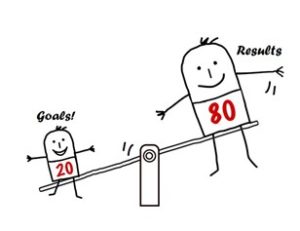
It is a peculiarity of man that he can only live by looking to the future.
(Viktor Frankl)
Traditionally, the first of any New Year is an excellent time to take stock of the prior year and make plans for the year to come.
Goals
In business, there are two (three, but for now, we will look at two) types of goals for your business:
- Production Goals
- Organization Goals
Setting production goals for where you want to be 12 months from now is the easy part of goal setting. The hard part is working out the organizational support you will need to achieve your production and collections goals. It could be more than you think!
But keep this in mind:
chiropractic and your services are never the primary barriers to practice success.
It is always management. It is the administrative issues connected with organization, including marketing, that gum up the work, gets in the way, slows your business down and holds you back.
Motivation
Part of management is managing your motivation. Yep… motivation needs to be managed. Keeping your spirits high and your drive strong is necessary for an organization to flow.
And this takes us back to your goals.
Visualizing achieving your goals will stimulate your motivation – and your drive. If you can’t see any way to your goals, well, that can be depressing. But if you can… if you can envision accomplishing your future goals, you will be motivated.
Viktor Frankl
I reference Viktor Frankl in my book, The Goal Driven Business.
Speaking of his experience in a concentration camp, “As we said before, any attempt to restore a man’s inner strength in the camp had first to succeed in showing him some future goal…”
He also said, “Even when it is not fully attained, we become better by striving for a higher goal.”
For your goal setting for the New Year, I recommend you start with your higher goals, the 3rd type of goal, which are beyond production and organization. For example, what brings you bliss? What gives you meaning?
- Time with family and friends?
- More vacations to more interesting places?
- Going for the WIN of your best production and collections year ever?
- Building a church?
- Getting a diplomate in nutrition?
- Improving patient outcomes?
- Speaking out about health issues more?
Begin with these goals – the higher, wilder, richer ones. Then, look at your production goals, then your organizational goals.
I encourage you to dream just a bit and look at next year as your playground. What higher, richer, and wilder adventures would you like to accomplish?
Have some fun considering these types of goals and all the ways you would like to achieve them. This will add zest and a special spirit to your production and organizational goals.
Help with Your Future
We want to help you with your future. Your work is important, and helping you achieve your goals has been a driving force and a higher goal within our company for over 30 years.
For 2023, we have a few openings for our Private Client status on our Goal Driven Program.
If you are interested in working with us, please reply to this email, and we will schedule a time to talk.
All of us at Petty Michel & Associates want to help you achieve your goals in 2023
Seize the Future! (Carpe Future)
Happy New Year
Ed
Reference. More information on this is covered in sections in The Goal Driven Business, starting at page 19 and page 116.










